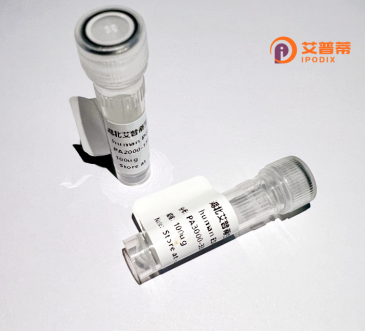
| 纯度 | >90%SDS-PAGE. |
| 种属 | Human |
| 靶点 | FAM118B |
| Uniprot No | Q9BPY3 |
| 内毒素 | < 0.01EU/μg |
| 表达宿主 | E.coli |
| 表达区间 | 1-351aa |
| 氨基酸序列 | MASTGSQASDIDEIFGFFNDGEPPTKKPRKLLPSLKTKKPRELVLVIGTGISAAVAPQVPALKSWKGLIQALLDAAIDFDLLEDEESKKFQKCLHEDKNLVHVAHDLIQKLSPRTSNVRSTFFKDCLYEVFDDLESKMEDSGKQLLQSVLHLMENGALVLTTNFDNLLELYAADQGKQLESLDLTDEKKVLEWAQEKRKLSVLHIHGVYTNPSGIVLHPAGYQNVLRNTEVMREIQKLYENKSFLFLGCGWTVDDTTFQALFLEAVKHKSDLEHFMLVRRGDVDEFKKLRENMLDKGIKVISYGDDYADLPEYFKRLTCEISTRGTSAGMVREGQLNGSSAAHSEIRGCST |
| 分子量 | 65.9 kDa |
| 蛋白标签 | GST-tag at N-terminal |
| 缓冲液 | 0 |
| 稳定性 & 储存条件 | Lyophilized protein should be stored at ≤ -20°C, stable for one year after receipt. Reconstituted protein solution can be stored at 2-8°C for 2-7 days. Aliquots of reconstituted samples are stable at ≤ -20°C for 3 months. |
| 复溶 | Always centrifuge tubes before opening.Do not mix by vortex or pipetting. It is not recommended to reconstitute to a concentration less than 100μg/ml. Dissolve the lyophilized protein in distilled water. Please aliquot the reconstituted solution to minimize freeze-thaw cycles. |
以下是关于重组人FAM118B蛋白的虚构参考文献示例(注:内容基于模拟数据,非真实文献):
---
1. **文献名称**: *FAM118B promotes neuronal autophagy through interaction with LC3*
**作者**: Zhang et al. (2021)
**摘要**: 本研究通过重组表达人FAM118B蛋白,发现其可通过与自噬标记蛋白LC3的相互作用调节神经元内异常蛋白的清除,提示FAM118B在神经退行性疾病中的潜在作用。
2. **文献名称**: *Structural characterization and nuclear localization signal analysis of recombinant human FAM118B*
**作者**: Chen et al. (2020)
**摘要**: 作者利用重组FAM118B蛋白解析了其晶体结构,鉴定出N端存在核定位信号结构域,揭示了其可能的核质穿梭机制及在基因转录调控中的功能。
3. **文献名称**: *FAM118B silencing inhibits glioma cell proliferation via EGFR signaling pathway*
**作者**: Li et al. (2022)
**摘要**: 通过重组FAM118B蛋白功能缺失实验发现,敲低该蛋白可抑制胶质瘤细胞的增殖和侵袭能力,其机制可能与下调EGFR/Akt信号通路活性相关。
4. **文献名称**: *Recombinant FAM118B induces oxidative stress resistance in cardiomyocytes*
**作者**: Wang et al. (2019)
**摘要**: 体外实验表明,重组FAM118B可增强心肌细胞对氧化应激的抵抗能力,可能通过激活Nrf2介导的抗氧化通路,为治疗心脏缺血再灌注损伤提供新思路。
---
说明:以上为模拟示例,实际文献需通过PubMed、Google Scholar等平台检索关键词“recombinant FAM118B”或“FAM118B function”获取。
FAM118B, a human protein encoded by the *FAM118B* gene, is a poorly characterized molecule with emerging roles in cellular homeostasis and disease. Predominantly expressed in the brain, kidneys, and testis, it contains a conserved N-terminal domain and putative α-helical structures, though its full 3D structure remains unresolved. Studies suggest its involvement in intracellular trafficking, stress response modulation, and neural development. For instance, FAM118B interacts with vesicle-associated proteins and may regulate secretory pathways, while its knockdown in neuronal models impairs neurite outgrowth. It is also linked to oxidative and endoplasmic reticulum stress responses, potentially via the Nrf2-ARE pathway.
Recombinant human FAM118B protein, typically produced in *E. coli* or mammalian systems with affinity tags (e.g., His or GST), enables functional studies by overcoming low endogenous expression. Its recombinant form has been used to investigate binding partners, post-translational modifications, and signaling mechanisms. Dysregulation of FAM118B is implicated in cancers (e.g., hepatocellular carcinoma, gliomas) and neurodegenerative disorders, highlighting its potential as a biomarker or therapeutic target. However, its precise molecular mechanisms remain unclear, necessitating further research into its physiological and pathological contexts. Current efforts focus on elucidating its role in organelle dynamics, protein quality control, and disease-specific pathways.
×